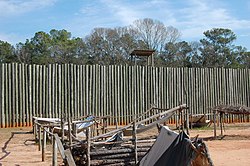Andersonville prison
|
Andersonville National Historic Site
|
|

Reconstruction of a section of the stockade wall
|
|
| Location | Macon / Sumter counties, Georgia, United States |
|---|---|
| Nearest city | Andersonville, Georgia, Americus, Georgia |
| Coordinates | 32°11′41″N 84°07′44″W / 32.19469°N 84.12895°WCoordinates: 32°11′41″N 84°07′44″W / 32.19469°N 84.12895°W |
| Area | 514 acres (208 ha) |
| Built | April 1864 |
| Visitation | 1,436,759 (2011) |
| Website | Andersonville National Historic Site |
| NRHP Reference # | 70000070 |
| Significant dates | |
| Added to NRHP | October 16, 1970 |
| Designated NHS | October 16, 1970 |
The Andersonville National Historic Site, located near Andersonville, Georgia, preserves the former Camp Sumter (also known as Andersonville Prison), a Confederate prisoner-of-war camp during the final twelve months of the American Civil War. Most of the site lies in southwestern Macon County, adjacent to the east side of the town of Andersonville. As well as the former prison, the site contains the Andersonville National Cemetery and the National Prisoner of War Museum.
The site is an iconic reminder of the horrors of Civil War prisons. It was commanded by Captain Henry Wirz, who was tried and executed after the war for war crimes. It was overcrowded to four times its capacity, with an inadequate water supply, inadequate food rations, and unsanitary conditions. Of the approximately 45,000 Union prisoners held at Camp Sumter during the war, nearly 13,000 died. The chief causes of death were scurvy, diarrhea, and dysentery. Friends provided care, food, and moral support for others in their social network, which helped prisoners survive.
The prison, which opened in February 1864, originally covered about 16.5 acres (6.7 ha) of land enclosed by a 15-foot (4.6 m) high . In June 1864, it was enlarged to 26.5 acres (10.7 ha). The stockade was rectangular, of dimensions 1,620 feet (490 m) by 779 feet (237 m). There were two entrances on the west side of the stockade, known as "north entrance" and "south entrance".
Robert H. Kellogg, sergeant major in the 16th Regiment Connecticut Volunteers, described his entry as a prisoner into the prison camp, May 2, 1864:
As we entered the place, a spectacle met our eyes that almost froze our blood with horror, and made our hearts fail within us. Before us were forms that had once been active and erect;—stalwart men, now nothing but mere walking skeletons, covered with filth and vermin. Many of our men, in the heat and intensity of their feeling, exclaimed with earnestness. "Can this be hell?" "God protect us!" and all thought that he alone could bring them out alive from so terrible a place. In the center of the whole was a swamp, occupying about three or four acres of the narrowed limits, and a part of this marshy place had been used by the prisoners as a sink, and excrement covered the ground, the scent arising from which was suffocating. The ground allotted to our ninety was near the edge of this plague-spot, and how we were to live through the warm summer weather in the midst of such fearful surroundings, was more than we cared to think of just then.
...
Wikipedia


